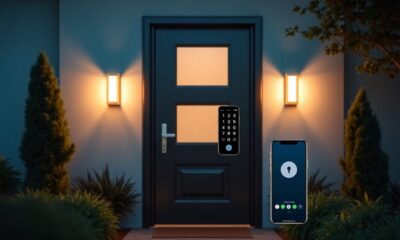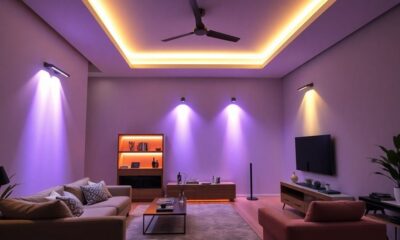Home Improvement
Home Lighting Design: Room-by-Room Guide
Optimize your home lighting design with our room-by-room guide that reveals essential tips for creating the perfect atmosphere—discover what’s missing in your spaces.
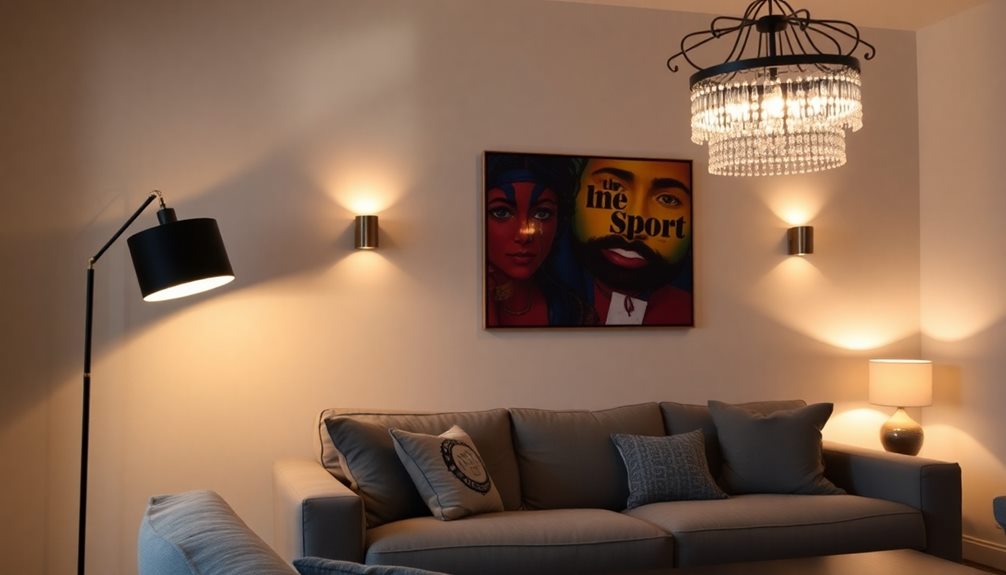
Your home lighting design plays an essential role in setting the atmosphere and functionality of each room. Start with layered lighting: ambient for overall brightness, task for specific activities, and accent to highlight features. In entryways, use ceiling fixtures with wall sconces for warmth. Living rooms benefit from dimmable lights and strategically placed lamps. For kitchens, opt for cool white lights, while warm tones work best in dining areas. Bedrooms should have soft lighting for relaxation, and home offices benefit from cooler lights to boost focus. Discover more tips to elevate your lighting game and enhance your living spaces.
Key Takeaways
- Layer different types of lighting—ambient, task, and accent—to enhance functionality and aesthetics in each room.
- Choose appropriate color temperatures: warm white (2700K) for living spaces and cooler (4100K) for kitchens and workspaces.
- Incorporate multiple light sources in every room to achieve balanced illumination and create inviting atmospheres.
- Use dimmers to adjust light intensity, catering to various activities and personal preferences easily.
- Aim for specific lumen levels: 10-20 for bedrooms, 70-80 for bathrooms, ensuring adequate brightness for tasks.
Importance of Indoor Lighting
Indoor lighting plays an essential role in shaping the atmosphere and functionality of your space. The right lighting design can dramatically impact your mood and overall well-being, especially during darker seasons when natural light is scarce.
Studies show that bright light exposure enhances productivity and health, while too much nighttime light can disrupt your sleep patterns. Additionally, just as selecting the appropriate cold medications is vital for effective relief, choosing the right lighting can also greatly influence your environment's comfort and efficacy.
When considering your lighting choices, prioritize ambient lighting that complements your activities. For example, well-lit environments have been shown to improve children's behavior and support their development. This highlights the need for thoughtful lighting in all rooms, ensuring everyone feels comfortable and focused.
Natural light is a key factor in lighting design; maximizing it can reduce utility costs and boost your mood. By allowing sunlight to filter in, you can create a warm, inviting atmosphere that positively affects your overall well-being.
Lighting Design Principles

Effective lighting design principles are essential for creating spaces that are both visually appealing and functional.
By understanding how to layer different types of lighting, you can enhance the versatility of your rooms. Here are three key principles to take into account:
- Layering Different Types of Lighting: Combine ambient lighting, task lighting, and accent lighting to create a well-rounded illumination strategy. This approach allows you to tailor the lighting based on your activities and preferences.
- Color Temperature Matters: Choose the right color temperature for each space. Warm light (2700K-3000K) creates a cozy atmosphere, while cool light (5000K-6500K) enhances focus and detail, making it perfect for work areas.
- Assess Your Lighting Needs: Every room has specific lighting requirements based on its size and function.
It's often beneficial to seek professional consultation to customize your lighting scheme effectively.
Entryway Lighting Solutions
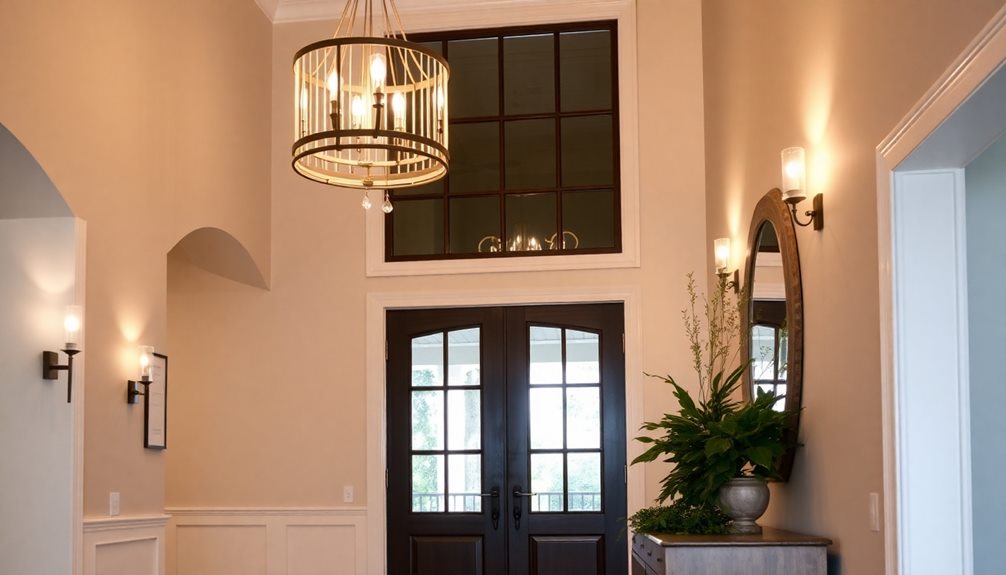
When you enter your home, the entryway sets the tone for the rest of the space, making it essential to get the lighting just right. Start with ceiling fixtures to provide necessary ambient light, but steer clear of potlights or downlights. These can create high contrast shadows that obscure visibility, making your entryway less welcoming. Aim for a brightness of 10-20 lumens per square foot to guarantee a functional and inviting atmosphere.
Next, incorporate layers in your lighting design. Combining ceiling fixtures with wall sconces allows you to add depth and dimension to the space.
Wall sconces can wash the walls with soft light, creating a warm and inviting feel. Don't forget about accent lighting; it can highlight artwork or decorative elements, enhancing your entryway's aesthetic appeal.
Living Room Lighting Ideas
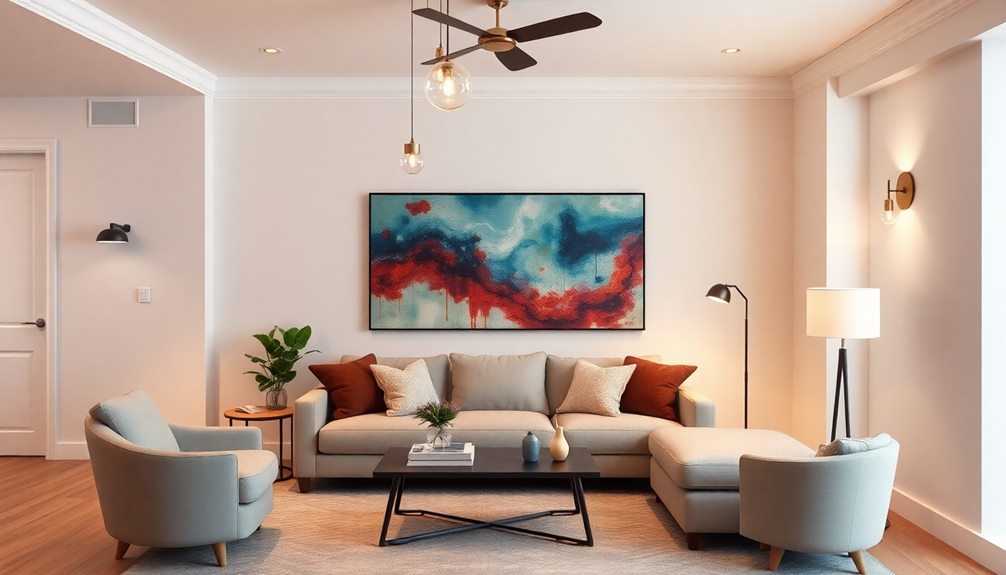
When it comes to living room lighting, a layered approach is key to achieving both function and style.
You'll want to mix ambient, task, and accent lighting through careful fixture selection, like chandeliers, floor lamps, and wall sconces.
This combination not only brightens the space but also enhances its visual appeal, making it perfect for any occasion.
Layered Lighting Approach
A layered lighting approach transforms your living room into a versatile and inviting space. By combining ambient, task, and accent lighting, you create an environment that's perfect for relaxation and functionality.
Here are three key lighting options to take into account:
- Ambient Lighting: Use ceiling fixtures or recessed lighting to provide overall illumination. Aim for 10-20 lumens per square foot to guarantee your living room is well-lit.
- Task Lighting: Enhance functionality with strategically placed floor or table lamps. These should minimize shadows and glare, making activities like reading or working more enjoyable.
- Accent Lighting: Highlight your living room's design features, like artwork or architectural details, with wall sconces or track lights. This adds visual interest and draws attention to your favorite elements.
Incorporating dimmable lights allows you to adjust brightness levels, so your living room can easily shift from bright and active to soft and intimate.
Fixture Selection Tips
Choosing the right fixtures for your living room is essential for creating a balanced and inviting atmosphere. Start by developing a lighting plan that incorporates various fixture types, including overhead lighting, table lamps, and floor lamps.
Contemplate blending modern elements with antiques to create a unique focal point in your space; incorporating antiques in decor can add character and charm. Pendant lights or chandeliers can serve as striking statement pieces while providing necessary overhead illumination. Just remember to hang them at a height of 30-36 inches above coffee tables or dining areas for ideal functionality.
For a layered effect, mix ambient lighting with accent lighting. Use adjustable recessed lighting to spotlight artwork or architectural features, enhancing the room's visual appeal without overwhelming the design.
Table lamps and floor lamps at varying heights won't only improve light distribution but also add depth and interest to your space.
When choosing bulbs, aim for a color temperature between 2700K and 3000K. This range creates a warm, cozy glow that promotes relaxation and comfort.
Don't forget to contemplate task lighting for reading or hobbies, ensuring your living room is both stylish and practical. By thoughtfully selecting your fixtures, you'll elevate the overall ambiance of your living room.
Kitchen and Dining Room Lighting

Effective kitchen and dining room lighting plays an essential role in both functionality and ambiance. To create the perfect lighting scheme, focus on these three key elements:
- Layered Lighting: Combine ambient lighting, like ceiling fixtures, with task lighting from under-cabinet sources. This guarantees you have ample illumination for cooking and food prep while enhancing the overall atmosphere.
- Kitchen Island Fixtures: When installing pendant lights above your kitchen island, space them about 30 inches apart. This not only provides even lighting but also adds a stylish touch to your kitchen.
- Dining Room Essentials: For dining areas, choose chandeliers or pendant fixtures and hang them 30-36 inches above the table. This height guarantees comfortable illumination without blocking views, making your dining experience more enjoyable.
Consider the color temperature as well; cool white light (around 4100K) is ideal for kitchens to reduce eye strain, while warm light (2700K) in dining rooms creates a cozy atmosphere that's perfect for relaxation.
Bedroom and Bathroom Lighting
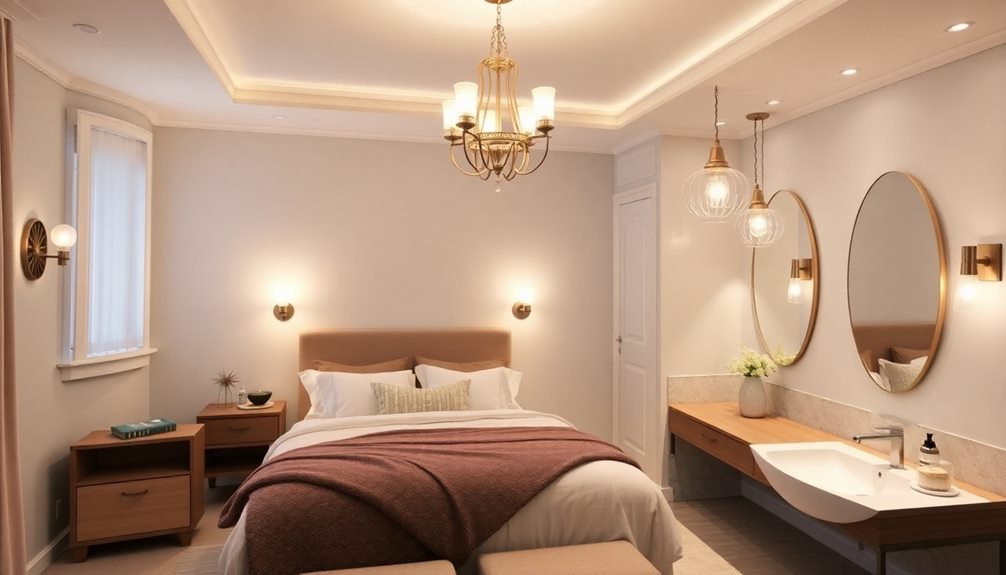
When it comes to bedroom and bathroom lighting, layering your lights is key for both functionality and comfort.
You'll want to contemplate color temperature to create the right mood, especially in your bedroom.
Plus, effective task lighting in the bathroom is essential for daily grooming tasks, so let's explore how to achieve that balance.
Layered Lighting Essentials
Layered lighting in your bedroom and bathroom can transform these spaces into functional yet inviting retreats. To achieve this, consider the following essentials:
- Ambient Lighting: Use ceiling fixtures or overhead lights to create a warm glow, setting the overall mood in the room.
- Task Lighting: Incorporate bedside lamps and vanity lighting at eye level to guarantee you have adequate light for reading or grooming, aiming for 70-80 lumens per square foot in your bathroom.
- Accent Lights: Highlight design features with accent lights, adding visual interest while guaranteeing functional task lighting supports your daily routines.
In your bedroom, utilizing recessed lighting with dimmer switches allows you to adjust the brightness for relaxation.
In the bathroom, position sconces or overhead fixtures strategically to minimize shadows and enhance visibility.
By layering these different types of lighting, you create a versatile environment that caters to various activities, from winding down at night to preparing for the day ahead.
Embrace layered lighting to elevate both your bedroom and bathroom into well-lit, inviting spaces.
Color Temperature Selection
Choosing the right color temperature for your bedroom and bathroom lighting plays an essential role in creating the desired ambiance. In your bedroom, opt for soft white bulbs around 2700K. This warm light fosters a cozy atmosphere, promoting relaxation and restful sleep.
When it comes to bathroom lighting, cooler white light, typically around 4100K, is the way to go. It provides brighter illumination, helping reduce eye strain during grooming tasks.
Consider incorporating adjustable color temperature lighting in both spaces. This versatility allows you to switch between warm and cool light based on the time of day and your specific activities. For instance, you might prefer a warm glow while unwinding in the evening, but want a brighter, cooler setting for morning routines.
Don't forget to test different color temperatures in your desired spaces. Colors can appear differently under various light conditions, so experimentation is essential to finding the most suitable option.
Task Lighting Importance
Selecting the right color temperature sets the stage for how your spaces feel, but task lighting plays a key role in functionality. In bedrooms and bathrooms, proper task lighting is essential for various activities. Here's why you shouldn't overlook it:
- Brightness Levels: Aim for 10-20 lumens per square foot in bedrooms for reading or studying, and 70-80 lumens per square foot in bathrooms for grooming tasks. This guarantees you have enough light without straining your eyes.
- Adjustable Fixtures: Incorporate adjustable fixtures like bedside lamps and wall sconces in your bedroom. This allows for personalized lighting control, enhancing comfort for different activities and moods.
- Optimal Lighting: Place light fixtures around mirrors at eye level in bathrooms. This setup provides bright, even light for your personal care routine and minimizes harsh shadows.
Utilizing energy-efficient LED bulbs in both spaces not only offers a range of color temperatures to match your preferences but also enhances the overall ambiance.
Home Office Lighting Tips
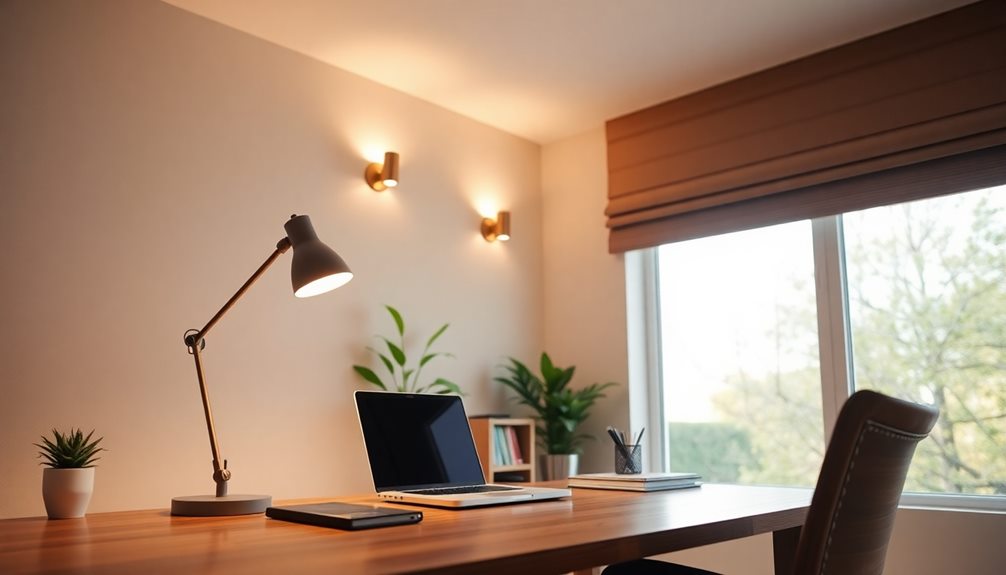
Creating an effective lighting setup in your home office can greatly enhance your productivity and comfort. To achieve a well-lit workspace, consider using a combination of ambient lighting and task lighting. Aim for a cooler light temperature between 3,000K and 5,000K to boost focus and minimize eye strain.
| Lighting Type | Purpose |
|---|---|
| Ambient Lighting | Overhead fixtures for overall illumination |
| Task Lighting | Desk lamps for specific tasks |
| Natural Light | Windows to brighten the space |
Position your task lighting to the side of your workstation to reduce glare on screens and guarantee even lighting for reading and writing. Dimmable lights can also be a game-changer, allowing you to adjust brightness according to the activity—perfect for video calls or brainstorming sessions.
Don't underestimate the power of natural light; it not only decreases your reliance on artificial lighting but also improves your mood and well-being. By strategically combining these elements, you'll create an inviting and efficient home office that keeps you motivated throughout the day.
General Lighting Best Practices
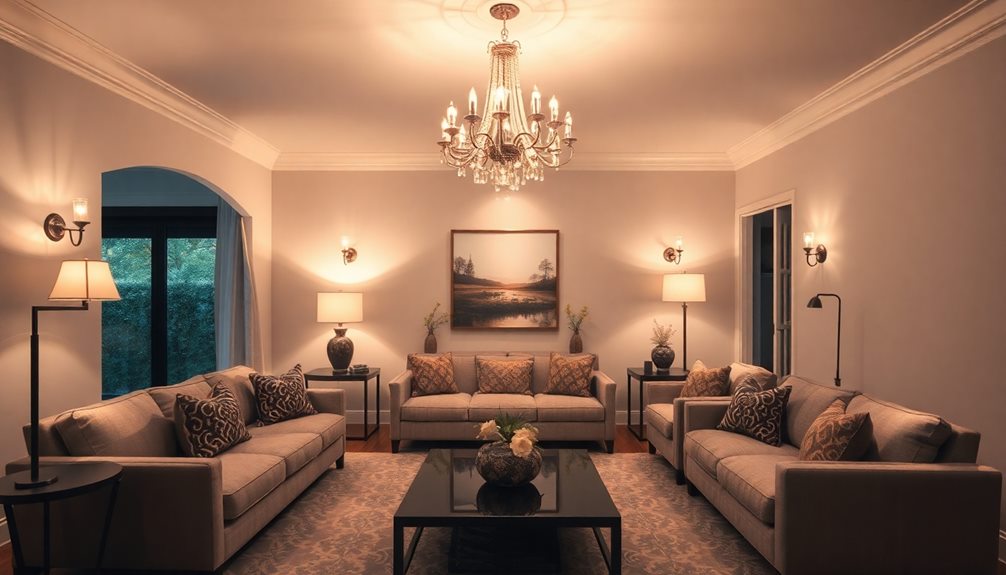
When designing your home's lighting, layering is key to achieving a balanced and inviting atmosphere. To create a versatile space, consider these general lighting best practices:
1. Use Multiple Light Sources: Aim for 2-3 light sources in each room. This reduces reliance on a single overhead fixture and enhances both functionality and aesthetic appeal.
Additionally, incorporating smart lighting options can provide greater control and customization, allowing for a more tailored experience, similar to smart bathroom technologies.
2. Choose the Right Color Temperature: Warm white (2700K) is perfect for living areas, while cooler color temperatures (4100K-5000K) work best in kitchens and workspaces to keep you alert and focused.
3. Incorporate Dimmers: Installing dimmers allows you to adjust light intensity easily. This adaptability caters to various activities and moods while helping you save on energy costs.
Additionally, opt for energy-efficient bulbs like LEDs. They not only cut down on electricity consumption but also boast a longer lifespan, making them a smart choice for your lighting fixtures.
Frequently Asked Questions
How Do You Layout Lights in a Room?
To layout lights in a room, sketch your space, identify key functions, and plan for multiple light sources. Consider fixture heights and spacing, then evaluate placement visually to guarantee balanced illumination throughout the area.
What Is the Rule of Thumb for Lighting Design?
For effective lighting design, aim for 10-20 lumens per square foot in living areas and 70-80 in kitchens. Use multiple light sources and consider color temperature to create a balanced, inviting atmosphere in each room.
How Do You Design a Lighting Layout?
To design a lighting layout, start by evaluating each room's function, sketch a detailed floor plan, incorporate various lighting types, document electrical needs, and consider smart systems for efficiency and convenience.
What Light to Use in Each Room?
Did you know that 90% of people notice lighting first when entering a room? Choose statement lights for entryways, layered options for kitchens, and cozy fixtures for living rooms to create inviting, functional spaces throughout your home.
Conclusion
Incorporating thoughtful lighting design throughout your home can transform each space, enhancing both functionality and ambiance. With the right fixtures and techniques, you can create a warm, inviting atmosphere that suits your lifestyle. So, why settle for dull, uninspired lighting when you can elevate your home's aesthetic? By applying the tips from this guide, you'll not only brighten your rooms but also enrich your daily experiences. Illuminate your life and enjoy the difference it makes!
Xavier – Your Operations Partner Xavier is your operations partner, working tirelessly behind the scenes to ensure that everything runs smoothly so you can enjoy a seamless experience with Perfect Fit Living. From managing inventory to coordinating logistics, he’s committed to making your experience with us hassle-free.
Home Improvement
Soundproofing Your Home: Professional Tips
Noise can disrupt your peace, but with expert soundproofing tips, you can transform your home into a serene sanctuary—discover how inside!
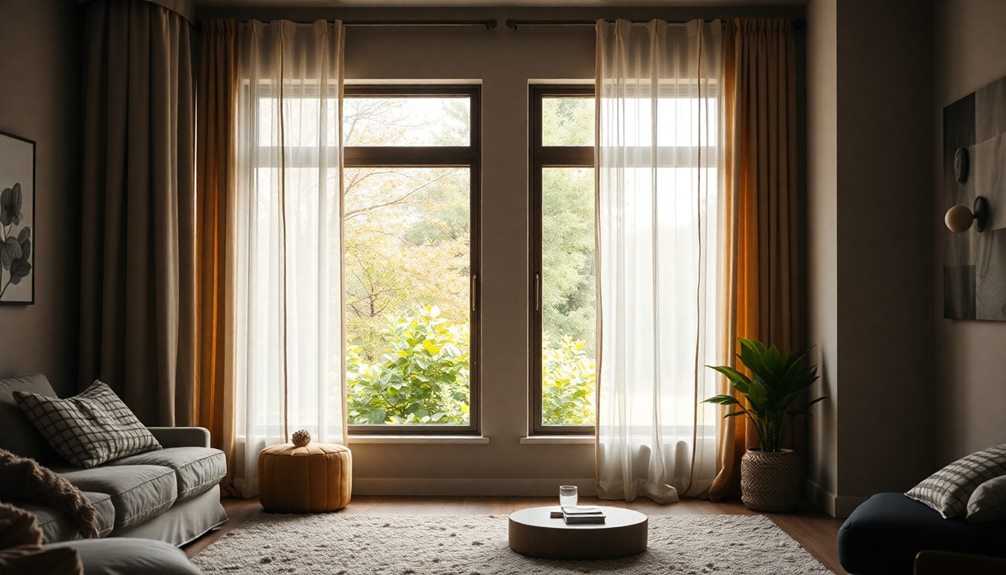
To soundproof your home effectively, start by addressing gaps that let noise through. Use mass-loaded vinyl along walls and ceilings to block sound, while acoustic insulation absorbs unwanted noise. Upgrade to double or triple-pane windows and install solid-core doors to greatly reduce external disturbances. Don't overlook floors; thick carpets and floating floors can minimize impact sound. Weather stripping and heavy curtains are simple DIY solutions to seal gaps and improve insulation. By applying these professional tips, you can create a quieter, more peaceful environment. There's so much more to explore on this topic!
Key Takeaways
- Install mass-loaded vinyl barriers to effectively block airborne and impact noises in walls and floors.
- Upgrade to double or triple-pane windows to reduce external noise by up to 70%.
- Utilize acoustic insulation in walls and ceilings to absorb sound waves and minimize reverberation.
- Seal gaps around doors and windows with weather stripping or acoustical sealant to prevent sound leakage.
- Consider soundproofing panels or heavy curtains to further enhance noise reduction in your living spaces.
Understanding Noise Challenges
In today's bustling world, understanding noise challenges in your home is essential for maintaining a peaceful living environment. Noise complaints, such as those from neighbors, are common, with 1 in 160 people in England reporting issues. Approximately 20% of the population lives in areas where harmful traffic noise intrudes, highlighting the need for effective soundproofing measures.
One major issue is sound transmission through tiny gaps in walls and structures. These gaps can allow sound waves to penetrate easily, similar to how small leaks affect waterproofing.
Sound waves can diffract around corners and find micro gaps, making it tough to identify specific noise sources. You might notice that lower frequency sounds, like those from traffic or machinery, travel longer distances and can be particularly disruptive.
To combat these challenges, understanding soundproof insulation and sound barriers is key. Implementing soundproofing techniques can help you reduce noise levels considerably, creating a more tranquil living space.
Effective Soundproofing Techniques
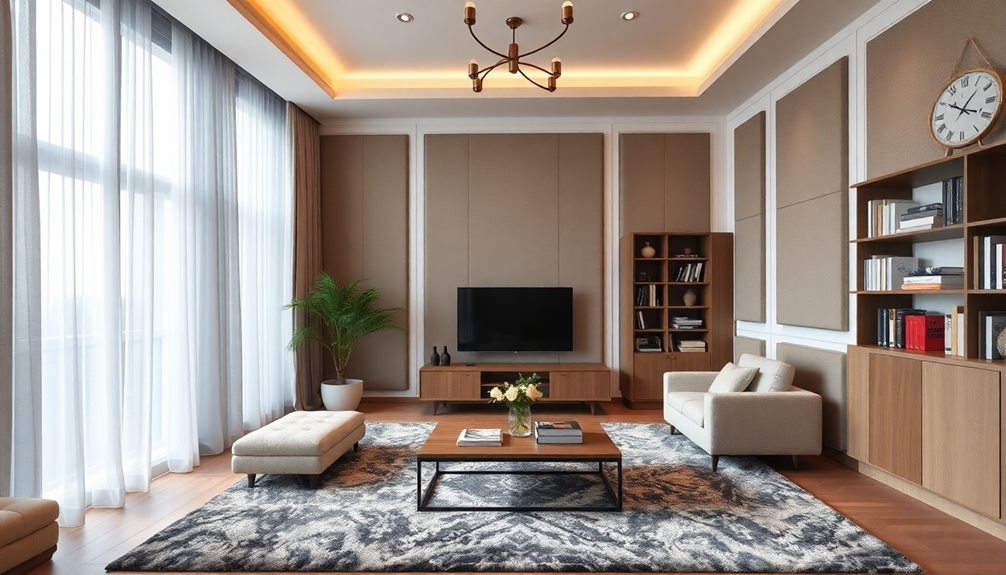
Effective soundproofing techniques can transform your home into a serene retreat, free from disruptive noise. By implementing various soundproofing solutions, you can greatly reduce noise transmission and create a more peaceful environment.
Here are some effective strategies to evaluate:
- Mass-loaded vinyl: Install this dense material behind drywall or under flooring to block both airborne and impact noises effectively.
- Acoustic insulation: Use acoustic panels on walls and ceilings to absorb sound waves and reduce reverberation, enhancing your home's overall acoustics.
- Decoupling techniques: Incorporate resilient channels or sound isolation clips to interrupt vibration transfer between wall layers, improving soundproofing in shared walls.
- Floating floors: These floors are structurally separate from the subfloor, minimizing impact noise from foot traffic, especially in multi-story homes.
Additionally, upgrading to double or triple-pane windows with laminated glass can bolster your soundproofing efforts.
Soundproofing Windows and Doors
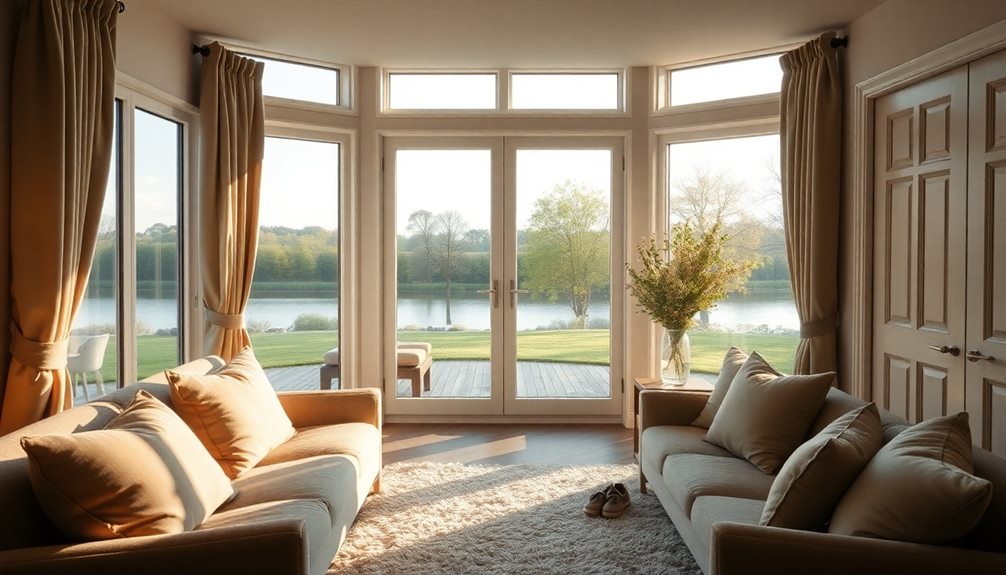
To achieve a quieter home, soundproofing your windows and doors is just as important as treating your walls and floors. Start by investing in double or triple-pane windows with laminated glass, which can reduce external noise transmission by up to 70%. If you're looking for an extra layer of protection, consider using acoustic window inserts. These panels create an air gap that absorbs sound, further enhancing noise reduction.
Don't forget about weather stripping around your window frames; sealing these gaps prevents sound leakage. For doors, opt for solid-core doors instead of hollow-core options. Their density makes them far more effective at blocking sound.
Here's a quick overview of effective soundproofing solutions:
| Solution | Benefits | Impact on Noise Reduction |
|---|---|---|
| Double/Triple-Pane Glass | Reduces external noise by 70% | High |
| Acoustic Window Inserts | Creates air gap for sound absorption | High |
| Weather Stripping | Seals gaps, prevents sound leakage | Moderate |
| Noise-Cancelling Curtains | Lowers noise levels by 50% | Moderate |
Strategies for Floors and Ceilings
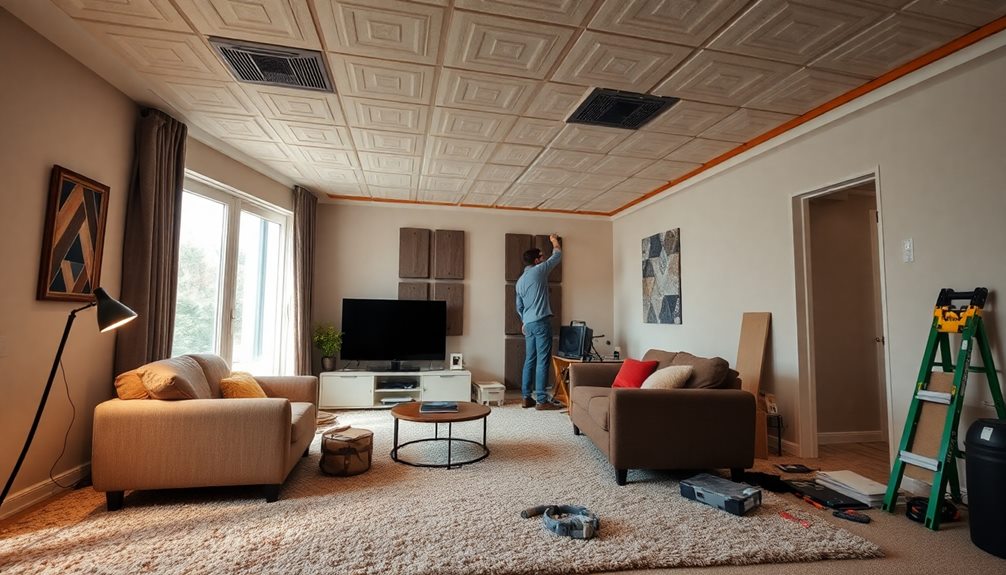
Creating a quieter home often hinges on the strategies you use for your floors and ceilings.
You can effectively reduce noise and improve your living space by implementing a few key solutions.
Here are some strategies to contemplate:
- Install soundproofing insulation between ceiling joists to dampen sound and minimize noise transmission, especially in multi-story homes.
- Use carpets and rugs with soundproof liners on hard flooring to absorb sound and vibrations, enhancing comfort in high-traffic areas.
- Incorporate acoustic tiles on your ceilings to absorb sound and block echoes, improving overall sound quality in your rooms.
- Consider suspended ceilings to create an air gap that helps decouple and dampen impact noise from above.
DIY Solutions for Soundproofing
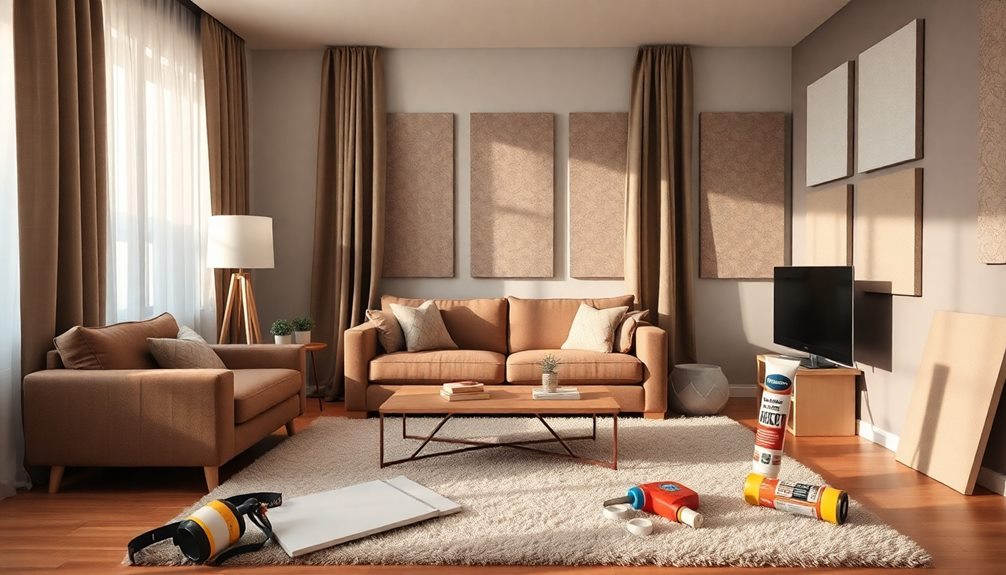
Soundproofing your home doesn't have to mean hiring professionals or spending a fortune. You can effectively tackle DIY solutions to soundproof a room and reduce noise.
Start by focusing on your doors and windows, sealing any gaps with weather stripping or acoustical sealant to block sound leakage. This can greatly improve your overall sound isolation.
Next, consider using heavy curtains or soundproof curtains. They not only enhance your decor but also provide additional insulation and block noise from outside.
If you have hard flooring, thick rugs or carpets can absorb sound and minimize noise transmission between rooms.
For shared walls, install bookshelves filled with books. This acts as a sound barrier, absorbing and diffusing sound waves effectively.
Additionally, consider applying soundproofing panels to your existing wall or ceiling. These panels come in various designs and can absorb sound and reduce reverberation in a room.
Frequently Asked Questions
How Do You Professionally Soundproof a Room?
To professionally soundproof a room, assess noise sources, then apply mass-loaded vinyl, resilient channels, and acoustic insulation. Upgrade to solid-core doors and double-pane windows for enhanced isolation. You'll create a quieter, more comfortable space.
How Do I Completely Soundproof My House?
You can't completely soundproof your house, but you can markedly reduce noise. Seal gaps, use high-density materials, install double-pane windows, and consider decoupling techniques to block sound effectively. Every step helps create a quieter space.
How Much Is Professional Soundproofing?
Ever wondered how much professional soundproofing costs? You'll likely spend between $1,000 and $10,000, depending on materials and installation complexity. On average, expect $2 to $5 per square foot for materials alone.
How Do I Block Noise on a Shared Wall?
To block noise on a shared wall, you can install acoustic panels, add mass with heavy materials, seal gaps with acoustic caulk, or place bookshelves against the wall for extra sound absorption.
Conclusion
In the symphony of life, silence is often the most beautiful note. By implementing these soundproofing techniques, you're not just blocking out noise; you're creating a sanctuary where peace reigns. Whether you opt for professional help or roll up your sleeves for a DIY project, remember that every effort transforms your space into a harmonious retreat. Embrace the tranquility, and let your home be the calm amidst the chaos of the outside world.
Xavier – Your Operations Partner Xavier is your operations partner, working tirelessly behind the scenes to ensure that everything runs smoothly so you can enjoy a seamless experience with Perfect Fit Living. From managing inventory to coordinating logistics, he’s committed to making your experience with us hassle-free.
Home Improvement
Bathroom Renovation: Cost-Effective Updates
Keen to elevate your bathroom without breaking the bank? Discover simple updates that can transform your space beautifully and affordably.
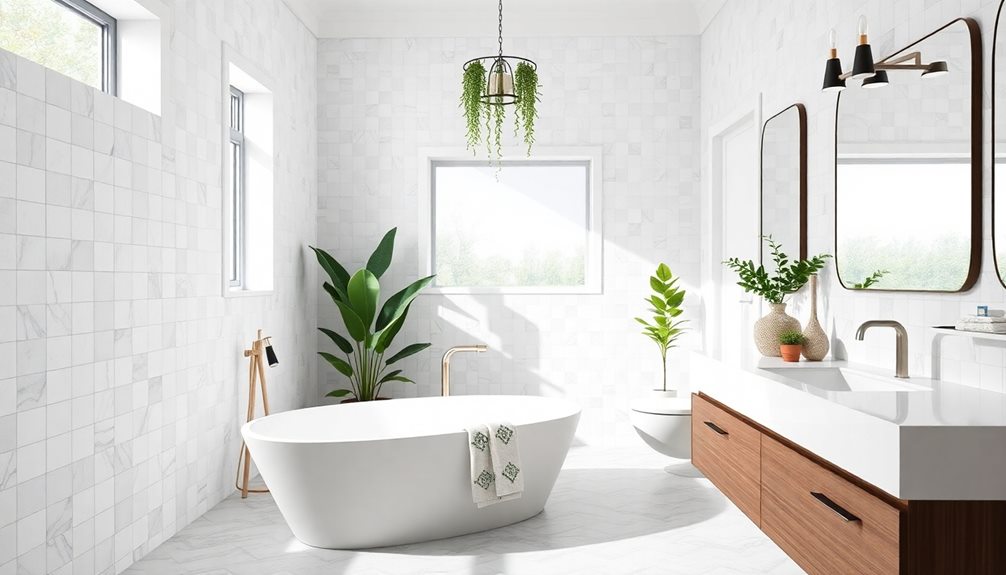
You can transform your bathroom with budget-friendly updates that boost both style and functionality. Start with a fresh coat of moisture-resistant paint to brighten the space, and consider peel-and-stick tiles for a quick floor refresh. Maximize storage with tall cabinets and floating shelves, keeping your essentials organized. Upgrade your vanity by repainting it or swapping out faucets for a modern touch. Enhance the atmosphere with layered lighting and larger mirrors. For a personal touch, change out hardware or add eco-friendly fixtures. There are plenty of ways to elevate your bathroom without overspending, and more ideas await you ahead.
Key Takeaways
- A fresh coat of moisture-resistant paint can rejuvenate your bathroom for $200 to $500, enhancing brightness and space perception.
- Cost-effective flooring options like peel-and-stick tiles and vinyl mimic expensive materials while ensuring durability and safety.
- Maximizing vertical storage with tall cabinets and floating shelves helps reduce clutter and maintains functionality without sacrificing floor space.
- Upgrading to energy-efficient lighting and larger mirrors can improve visibility and create a more spacious feel while reducing electricity costs.
- Simple hardware updates, like new knobs or spray-painted pulls, can refresh your bathroom's look affordably and with minimal effort.
Affordable Painting Solutions
When you're looking to spruce up your bathroom without breaking the bank, affordable painting solutions can really transform the space. A fresh coat of paint can rejuvenate your bathroom's appearance at a fraction of the cost of major renovations.
Additionally, upgrading to energy-efficient fixtures, such as heat pumps, can further enhance the comfort and air quality of your bathroom area while being cost-effective in the long run, as they contribute to energy savings with commercial heat pumps.
DIY painting projects usually cost between $200 and $500, depending on the size and quality of the paint.
Using moisture-resistant paint is essential in bathrooms, as it prevents peeling and mold, ensuring a durable finish that withstands the humidity. Opting for light colors, like whites and pastels, can create the illusion of a larger and brighter space, making them perfect for smaller bathrooms.
If you want to add a pop of personality, consider painting an accent wall in a bold color or pattern. This approach allows you to express your style without committing to a full remodel.
Cost-Effective Flooring Choices
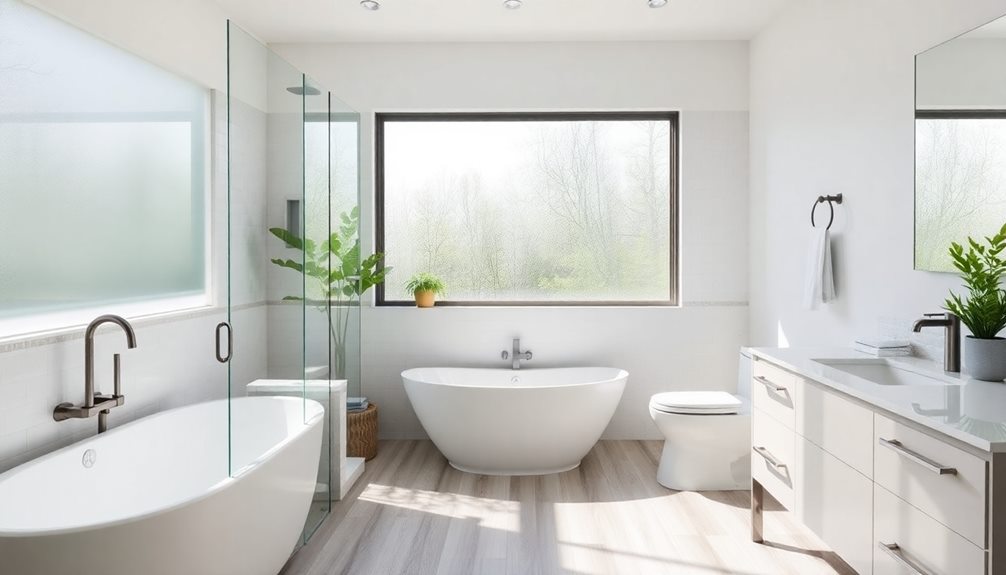
After revitalizing your bathroom with a fresh coat of paint, flooring choices play a significant role in completing the transformation.
You'll want to explore cost-effective options that suit your style and budget. Peel-and-stick tiles are a fantastic DIY option, allowing you to refresh your space without hiring professionals. They're simple to install and come in various designs and can be paired with modern fixtures, like smart toilets, to enhance the overall user experience.
Vinyl flooring is another budget-friendly choice that mimics the look of more expensive materials like wood or stone, providing durability and comfort. Waterproof laminate flooring is perfect for humid environments, combining the aesthetic of wood with moisture resistance.
Safety should also be a priority; look for slip-resistant surfaces in budget-friendly tiles to reduce the risk of falls.
If you're willing to invest a bit more, consider upgrading to heated flooring. While it comes with installation costs ranging from $1,500 to $3,000, the luxury and warmth it adds to your bathroom can be worth it.
With these options, you can achieve a beautiful and functional bathroom floor that meets your needs without breaking the bank.
Maximizing Storage Space
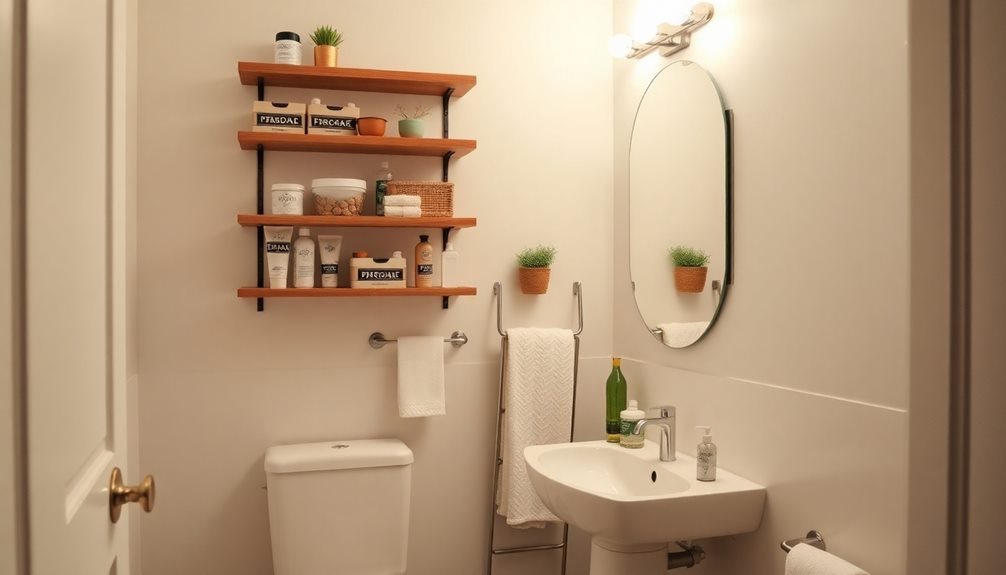
When it comes to maximizing storage in your bathroom, tall storage cabinets are a game changer, helping you organize essentials while reducing clutter.
Additionally, incorporating farmhouse kitchen cabinet ideas can inspire creative storage solutions that blend style with functionality.
You can also utilize floating shelves to keep frequently used items within reach without sacrificing floor space.
Don't forget about baskets and bins; they can keep your toiletries tidy and easy to find, enhancing your bathroom's overall functionality.
Tall Storage Cabinets
Maximizing storage space in your bathroom is as simple as incorporating tall storage cabinets. These cabinets effectively utilize vertical space, allowing you to store your essentials without occupying much floor area.
With multiple shelves and adjustable options, they're perfect for organizing essentials like toiletries and linens in a way that suits your needs.
When selecting tall storage cabinets, consider those made from mildew-resistant materials. This choice guarantees durability and hygiene in the humid bathroom environment, helping you maintain a clean and healthy space.
By adding a tall storage cabinet, you can greatly reduce clutter, leading to a more serene atmosphere that enhances your overall wellness.
You'll be pleased to find that there are budget-friendly options available at various retailers, with prices typically ranging from $100 to $500. This range makes it easy to find a cabinet that fits your style and budget.
Whether you prefer a sleek modern design or a classic look, you can discover the perfect tall storage cabinet to elevate your bathroom's functionality while keeping it organized and tidy.
Embrace the benefits of tall storage cabinets and transform your bathroom into a more efficient space.
Floating Shelves Benefits
Floating shelves are a smart solution for maximizing storage space in your bathroom, especially if you're dealing with limited square footage. By utilizing vertical wall areas, you can keep your floor clear and create an organized environment. These shelves can be customized in size and material to seamlessly fit your bathroom's aesthetic while offering functional storage.
Here's a quick overview of floating shelves benefits:
| Benefit | Description | Example Use |
|---|---|---|
| Space-saving | Utilize vertical space without sacrificing floor area | Store toiletries |
| Customizable | Tailor size and material to match your style | Match with bathroom decor |
| DIY-friendly | Easy installation for homeowners | Install without pros |
| Moisture resistant | Use mildew-resistant materials for durability | Ideal for humid bathrooms |
Floating shelves can hold essential items like toiletries or decorative accessories, enhancing organization and reducing clutter. They're also a DIY-friendly and affordable option for revitalizing your space without breaking the bank. With the right materials, these shelves will stand up to the humid conditions of a bathroom, ensuring they last for years to come.
Baskets and Bins
Incorporating baskets and bins into your bathroom design can considerably enhance your storage capabilities while keeping your space organized. These versatile storage solutions effectively reduce clutter, allowing you to easily organize toiletries, towels, and cleaning supplies.
By using labeled bins for specific items, you'll streamline daily routines, guaranteeing quick access to essentials and promoting a tidy environment.
Opt for bins made from mildew-resistant materials to maintain hygiene in your humid bathroom. This choice not only guarantees durability but also keeps your storage areas fresh and clean.
Combining floating shelves with decorative baskets can maximize vertical space, providing additional storage without occupying valuable floor area. This clever use of space adds both functionality and style to your bathroom.
Consider mixing sizes and styles for your baskets and bins. Coordinating colors and textures creates visual interest while maintaining a cohesive look.
Whether you choose wicker, fabric, or plastic, the right combinations can elevate your bathroom's aesthetic. With thoughtful organization and effective storage solutions, you'll transform your bathroom into a clutter-free oasis that's both practical and visually appealing.
Enhancing Mirrors and Lighting
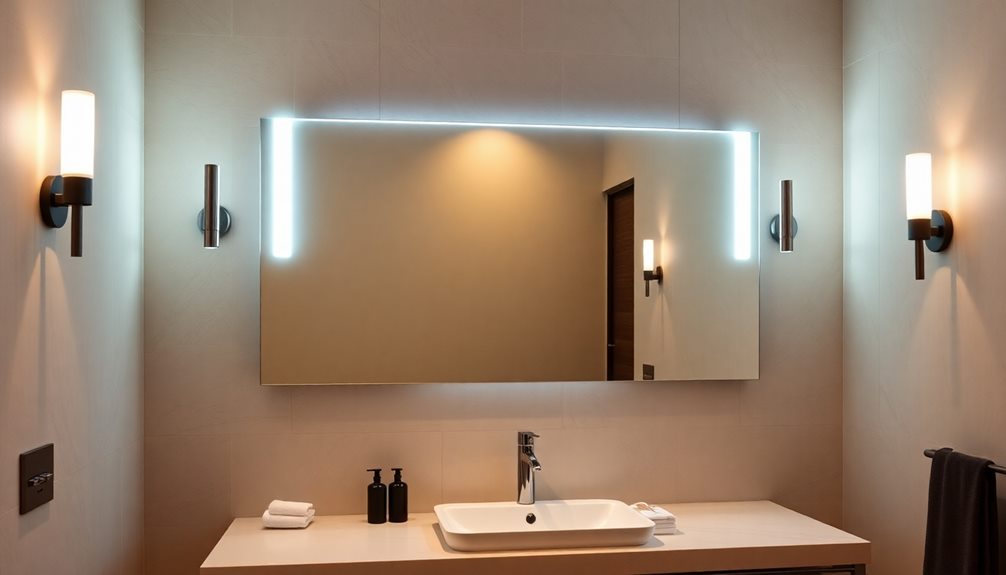
When you think about upgrading your bathroom, enhancing mirrors and lighting can make a notable impact on both space and ambiance.
Start by choosing larger mirrors that create the illusion of space and enhance natural lighting, making your bathroom feel more open and inviting. Consider adding fog-free mirrors with integrated LED lighting; they not only improve visibility but also introduce a sleek, modern touch to your decor.
Layered lighting is essential for a well-designed bathroom. Incorporate ambient, task, and accent options to improve functionality while setting the right mood.
By using energy-efficient bulbs, you can greatly reduce electricity costs and contribute to a sustainable renovation.
Don't forget about dimmers on light fixtures. Installing them allows you to adjust brightness levels, creating the perfect atmosphere whether you're winding down after a long day or prepping for the morning hustle.
With these upgrades, you'll transform your bathroom into a space that's not only stylish but also practical and energy-conscious.
Budget-Friendly Vanity Upgrades
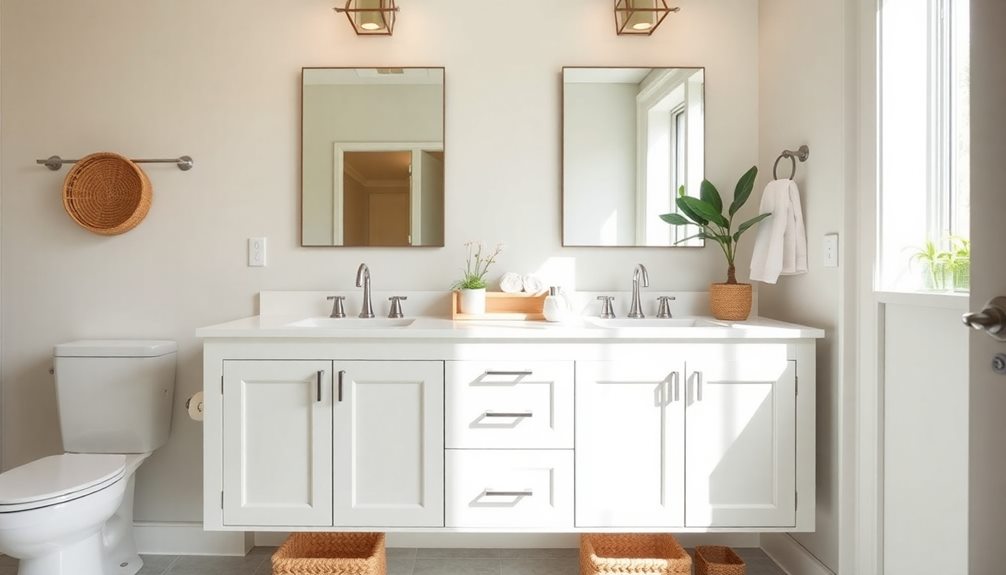
Upgrading your vanity doesn't have to break the bank.
You can find affordable options that elevate your bathroom's look or tackle DIY improvements to refresh your existing setup.
With a bit of creativity and smart choices, you can achieve a stylish and functional space without overspending.
Affordable Vanity Options
Transforming your bathroom doesn't have to cost a fortune, especially when it comes to choosing affordable vanity options. One of the easiest budget-friendly upgrades is simply repainting your existing vanity. This can often cost less than $100, while a new double vanity can set you back $750 or more.
If you prefer a new piece, stylish wood vanities often come in under $500, providing both functionality and aesthetic appeal. To maximize your space, consider incorporating smart storage solutions within your vanity. This helps keep your bathroom organized without the need for costly renovations.
If you're dealing with peeling surfaces, don't stress—using contact paper can give your vanity a fresh look at a fraction of the replacement cost. Additionally, you can rejuvenate your vanity's appearance with new faucets and sinks, which can be replaced for as little as $100.
These upgrades not only enhance the look but also improve functionality. By exploring these affordable vanity options, you'll achieve a stunning bathroom remodel that aligns with your budget and style.
DIY Vanity Improvements
A stunning bathroom centerpiece can be achieved through DIY vanity improvements that won't break the bank. You can start with budget-friendly painted finishes to breathe new life into your existing vanity.
Replacing old faucets and sinks can also rejuvenate the space, with options ranging from $50 to $500 depending on style and material.
To enhance functionality and keep your bathroom design tidy, consider adding storage solutions like organizers or baskets within the vanity. These cost-effective updates require minimal effort and can greatly improve your space.
If your vanity surface is peeling or cracking, using contact paper is a smart choice for an affordable aesthetic refresh for as little as $20.
For a more substantial upgrade, think about incorporating a new countertop. With options from laminate at around $50 to high-end stone materials exceeding $1,000, you can find something that fits your budget and style.
Bathtub Refresh Ideas
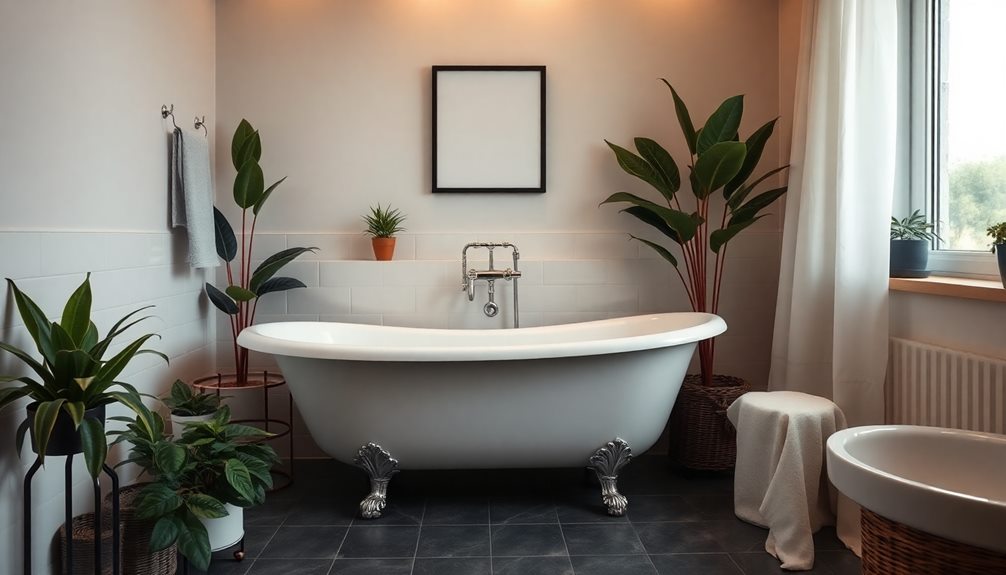
When it comes to giving your bathroom a quick boost, rejuvenating your bathtub can be a game-changer. One of the most cost-effective ways to refresh your bathtub is through reglazing. This process can make your old tub look brand new for a fraction of the cost of replacement, typically between $300 and $600.
If you're looking for an even more affordable upgrade, consider adding a bathtub liner. This option provides a clean surface without the hassle of a full renovation, costing around $1,000 to $1,500.
Updating your bathtub fixtures can also modernize the look and functionality of your space. Depending on the style and quality, you can find faucets and showerheads ranging from $50 to $300.
For a budget-friendly aesthetic refresh, don't overlook accessories like a stylish shower curtain, which can cost as little as $20 to $100. If you're feeling adventurous, DIY refinishing kits are available at local home improvement stores for $30 to $100.
With these ideas, you can easily give your bathtub a fresh feel without breaking the bank.
Personalizing Hardware

Updating the hardware in your bathroom can make a noticeable difference without a hefty price tag. By personalizing hardware, you can refresh the look of your space with unique knobs and pulls that add character and style.
Focus on selecting quality bathroom hardware that complements your plumbing fixtures for a cohesive aesthetic. Inexpensive hardware options are widely available at various retailers, making it easy to find pieces that suit your taste without breaking the bank.
Swapping out cabinet hardware, like knobs and drawer handles, is a straightforward DIY project that you can complete in just a few hours. This simple update can yield significant visual impact.
If you want a truly customized look, consider using spray paint to refresh your existing hardware. This cost-effective solution allows you to choose colors and finishes that enhance your overall bathroom design.
With just a little effort and creativity, you can transform your space, making it feel more personalized and inviting. Remember, even small changes can lead to a big difference in your bathroom's atmosphere.
Eco-Friendly Improvements
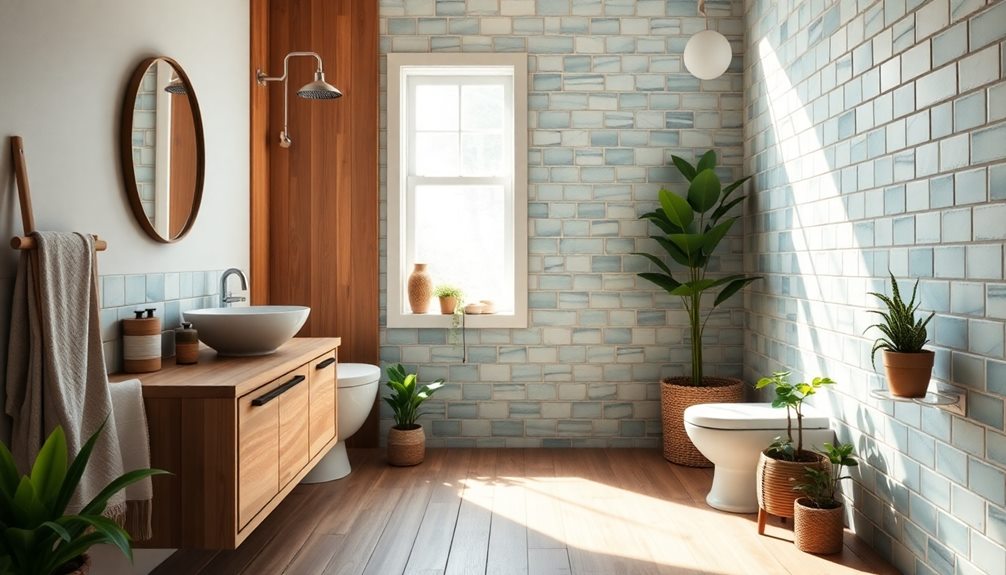
Making eco-friendly improvements in your bathroom not only benefits the environment but can also enhance your home's comfort and style.
Start by installing low-flow toilets, which can cut your water usage by up to 60%. This change not only helps the planet but can also lead to significant savings on your water bills.
Next, consider upgrading to Energy Star-rated fixtures and appliances. This choice can save you an average of $100 per year on energy costs, making it both financially wise and environmentally responsible.
Additionally, using sustainable materials like bamboo or reclaimed wood for your vanities and countertops not only reduces your environmental impact but also adds a unique aesthetic to your space.
Don't forget about indoor air quality. Incorporating plants into your bathroom design can improve air quality while creating a calming atmosphere.
Finally, opt for eco-friendly paint with low volatile organic compounds (VOCs) to guarantee a healthier environment for you and your family.
Frequently Asked Questions
What Is a Realistic Budget for a Bathroom Remodel?
When budgeting for a bathroom remodel, aim for $9,000 to $28,500 for a standard update. Remember to factor in unexpected costs and plan for around $600 to $800 per square foot for materials and labor.
Can You Redo a Bathroom for ?
Yes, you can redo a bathroom for $5,000 by focusing on cosmetic changes, prioritizing essential updates, using DIY skills, and shopping smartly. With strategic choices, you'll create a fresh, inviting space without overspending.
How Can I Update My Bathroom Without Replacing It?
You can update your bathroom without replacing it by painting in fresh colors, installing peel-and-stick tiles, replacing hardware, upgrading lighting, and adding decorative elements. These simple changes can transform your space effectively and affordably.
Does Updating a Bathroom Add Value?
Imagine transforming your bathroom into a serene retreat. Updating it can indeed add value, enhancing your home's appeal and making it more inviting to potential buyers who seek a touch of luxury and comfort.
Conclusion
Incorporating these cost-effective updates can transform your bathroom without breaking the bank. Did you know that a fresh coat of paint can increase your home's value by up to 5%? By focusing on affordable solutions like painting, flooring, and storage, you can create a space that feels new and inviting. Remember, small changes like personalized hardware and lighting can make a big impact. So, get started on your renovation journey today and enjoy the results!
Xavier – Your Operations Partner Xavier is your operations partner, working tirelessly behind the scenes to ensure that everything runs smoothly so you can enjoy a seamless experience with Perfect Fit Living. From managing inventory to coordinating logistics, he’s committed to making your experience with us hassle-free.
Home Improvement
Energy-Efficient Window Treatments: Complete Guide
Cut your energy costs and enhance comfort with our complete guide to energy-efficient window treatments—discover the best options for your home today!
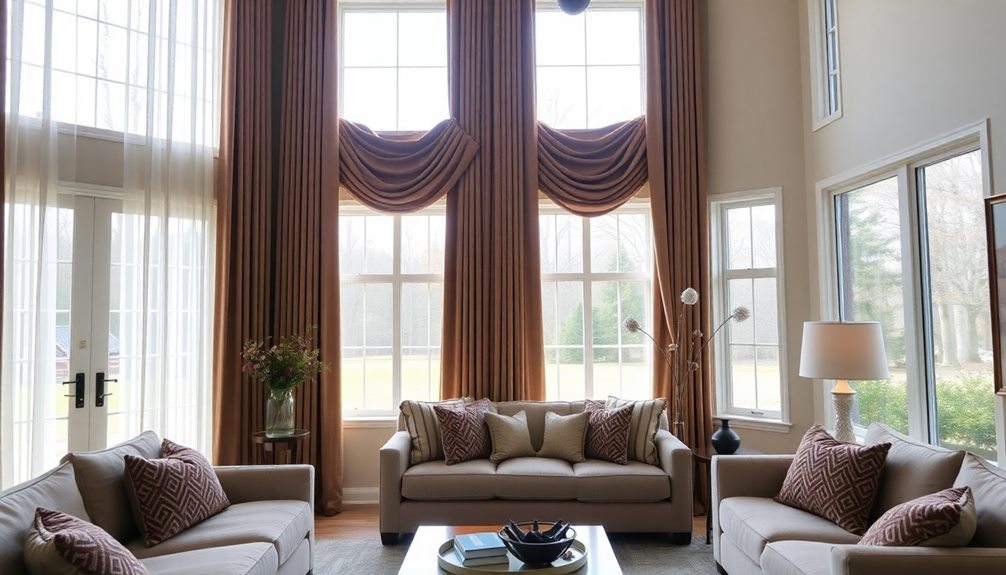
Energy-efficient window treatments can cut your energy costs considerably and boost your home's comfort. Options like cellular shades and blackout shades provide excellent insulation and light control. Consider the climate and window orientation when choosing the best treatments for your space. You can maximize efficiency by layering different types or installing reflective films. Plus, regular maintenance guarantees they work effectively over time. Exploring trendy materials and smart technologies also enhances both style and functionality. For even more tips and strategies on optimizing these treatments, keep going!
Key Takeaways
- Energy-efficient window coverings can reduce energy loss through windows by up to 40%, lowering heating and cooling costs significantly.
- Consider cellular shades, blackout shades, thermal drapes, plantation shutters, and window films for optimal insulation and light control.
- Select window treatments based on climate, window size, sunlight exposure, aesthetic appeal, and budget for maximum energy efficiency.
- Adjust window coverings seasonally and layer treatments to enhance insulation and regulate indoor temperature effectively.
- Explore available tax incentives for investing in energy-efficient window treatments to improve home comfort and reduce environmental impact.
Benefits of Energy Efficient Window Coverings
When you choose energy-efficient window coverings, you're not just enhancing your home's aesthetic; you're also making a smart investment in comfort and savings.
These coverings can reduce energy loss through windows by up to 40%, which considerably lowers your heating and cooling costs. By blocking harmful UV rays, they protect your furniture and flooring from fading, extending their lifespan and maintaining your home's appeal.
Additionally, energy-efficient window coverings enhance indoor comfort by regulating temperature and minimizing hot and cold spots, creating a more enjoyable living environment year-round. This improved energy efficiency translates into long-term financial benefits, as you'll notice lower utility bills over time.
Moreover, using these treatments contributes to a decrease in greenhouse gas emissions due to reduced energy consumption, which helps you lower your carbon footprint.
The energy savings you gain from these window coverings not only benefit your wallet but also the planet, making it a win-win situation. Investing in energy-efficient solutions today means you can enjoy a more comfortable home while reaping the rewards for years to come.
Types of Energy Efficient Treatments
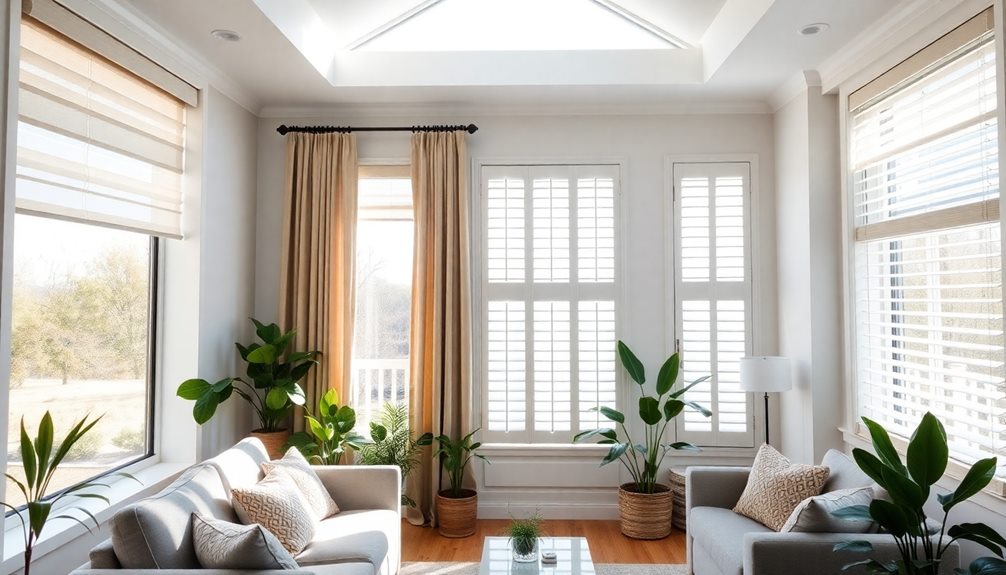
Choosing the right type of energy-efficient window treatment is key to maximizing your home's comfort and savings.
Consider cellular shades, which feature a honeycomb design that traps air, providing excellent insulation and reducing energy loss by up to 40%.
If you want to block out light effectively, blackout shades are your best bet, blocking nearly 100% of outdoor light and greatly reducing heat gain.
For a stylish option, drapes with thermal lining enhance insulation by minimizing heat transfer. Layering them with sheer curtains allows you to maintain natural light while improving energy efficiency.
Plantation shutters also offer energy-saving benefits; their tightly installed panels and adjustable louvers provide both light control and insulation.
If you're looking for a solution that doesn't change your existing decor, consider window films. They reflect heat and harmful UV rays, enhancing energy efficiency without compromising your aesthetic.
Factors for Choosing Window Coverings
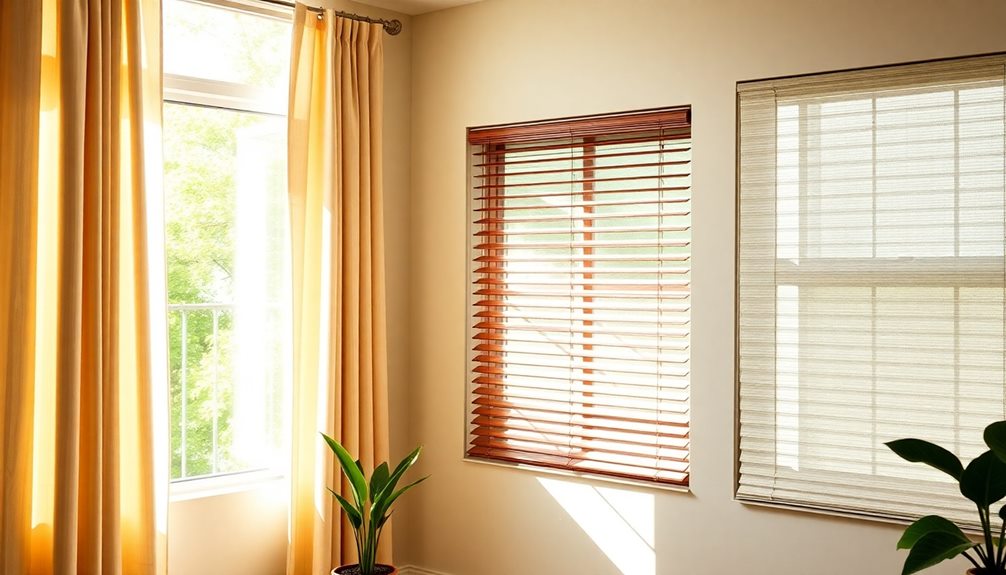
What factors should you consider to find the perfect window coverings for your home? First, evaluate your climate. If you live in a colder area, insulated options are essential, while reflective films work best in warmer regions to minimize heat gain. Next, think about your window size and orientation. Larger windows may require more efficient coverings, and south-facing windows need treatments that effectively block heat.
Sunlight exposure is another critical factor. South-facing windows benefit from coverings that reduce heat, while north-facing ones can use less reflective materials.
Lastly, don't forget about aesthetics and budget constraints. Matching window treatments with your home decor enhances visual appeal while maintaining functionality. Weigh the initial costs against potential long-term energy savings for a well-informed decision.
| Factor | Considerations | Examples |
|---|---|---|
| Climate | Cold vs. warm environments | Insulated options vs. reflective films |
| Window Size & Orientation | Larger vs. smaller windows, direction | Efficient insulated coverings for large windows |
| Sunlight Exposure | Amount of direct sunlight | Heat-reducing for south-facing windows |
| Aesthetic Appeal | Design compatibility with decor | Colors and styles that match |
| Budget Constraints | Initial costs vs. long-term savings | Cost-effective energy-efficient window treatments |
Maximizing Energy Efficiency Strategies
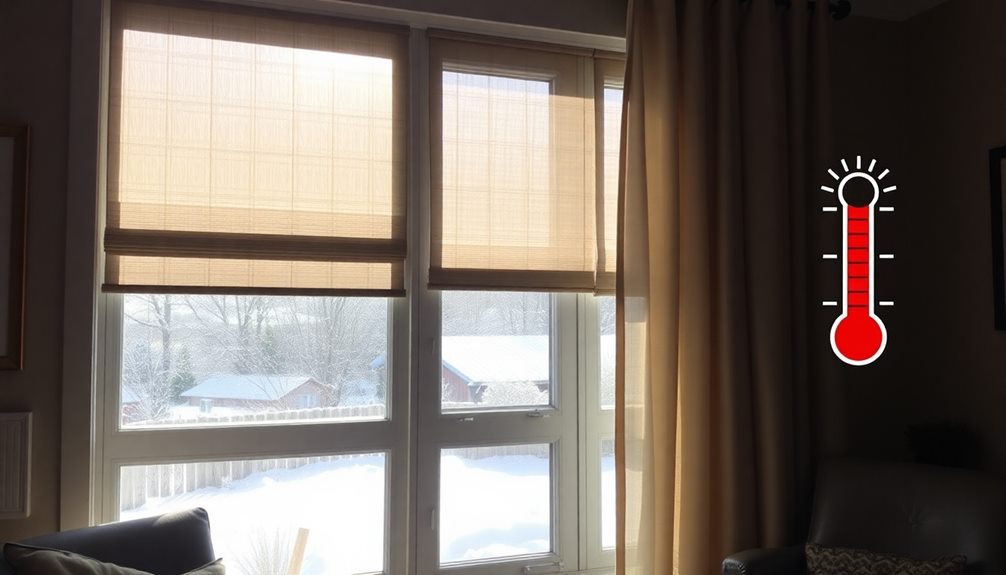
To maximize energy efficiency in your home, consider implementing a variety of strategies that adapt to seasonal changes.
Start by adjusting your window treatments seasonally; close them at night in winter to trap heat and open them during the day in summer to let in cool breezes. This simple act can greatly regulate indoor temperatures.
Installing window films on south-facing windows is another great way to reduce energy costs. These films can block up to 99% of harmful UV rays and drastically cut heat gain, which helps lower your cooling expenses.
For even greater energy efficiency, consider layering thermal curtains with cellular shades. This combination can reduce energy loss through windows by as much as 50%.
Don't forget to regularly clean your window treatments. Dust and debris can diminish their insulating properties, decreasing their overall effectiveness.
Finally, look into tax incentives for energy-efficient home improvements, which can offer you financial benefits while promoting sustainable practices in your window treatment choices.
Seasonal Trends and Maintenance Tips
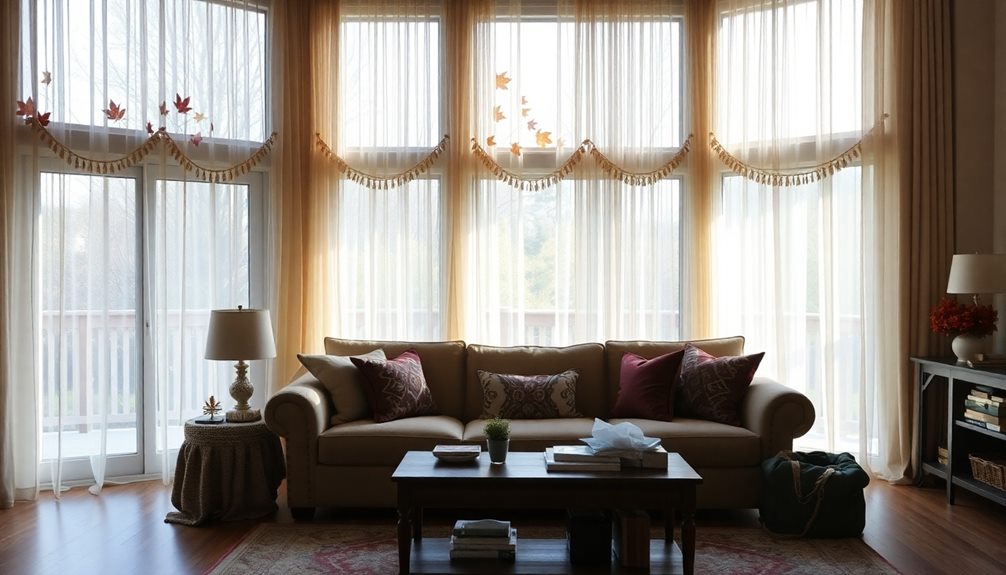
As the seasons change, so do the trends in window treatments that not only enhance your home's aesthetic but also boost energy efficiency. This year, you'll notice a rise in natural materials like bamboo and jute, which add an organic touch while ensuring durability.
Bold patterns and textures are also making a statement, reflecting personalized styles that can invigorate your space.
For energy-efficient window coverings, maintenance is key. Regular cleaning helps preserve their appearance and performance, especially for delicate fabrics. Consider professional cleaning to maintain intricate designs without damaging them.
During the holidays, festive colors and decorative elements can elevate your decor, but don't forget to incorporate thermal curtains for better insulation.
Layering techniques are increasingly popular, allowing you to combine drapes with shades for added depth and energy efficiency—perfect for seasonal shifts.
Plus, smart technology integration in window treatments makes it easy to automate adjustments, aligning with the trend toward minimalism and functionality.
Frequently Asked Questions
What Type of Window Covering Is Most Energy-Efficient?
When it comes to energy efficiency, cellular shades are exceptional. Their honeycomb design traps air, reducing energy loss greatly. You'll appreciate how they help maintain comfortable indoor temperatures and lower your energy bills.
What Is the Most Energy-Efficient Window Style?
The most energy-efficient window style is double-glazed windows. They reduce heat transfer considerably, and if you add low-emissivity coatings, you'll enhance their efficiency even more, making them a smart choice for your home.
Which Window Frames Are Most Energy-Efficient?
When choosing window frames, consider vinyl for insulation, wood for natural warmth, or fiberglass for thermal performance. Aluminum's less efficient unless it has a thermal break, while composite frames blend durability with insulation effectively.
What Are the Most Cost Effective Window Treatments?
Did you know cellular shades can reduce energy loss by up to 40%? For cost-effective window treatments, consider blackout curtains, thermal drapes, or window films, all providing significant savings while improving your home's energy efficiency.
Conclusion
Incorporating energy-efficient window treatments is like giving your home a cozy blanket; it keeps the warmth in during winter and the heat out in summer. By carefully selecting the right coverings, you not only enhance your comfort but also trim down those energy bills. Remember, just as a well-timed hug can lift your spirits, the right window treatments can transform your living space, making it more inviting while benefiting the environment. So go ahead, embrace the change!
Xavier – Your Operations Partner Xavier is your operations partner, working tirelessly behind the scenes to ensure that everything runs smoothly so you can enjoy a seamless experience with Perfect Fit Living. From managing inventory to coordinating logistics, he’s committed to making your experience with us hassle-free.
-

 Vetted5 months ago
Vetted5 months ago14 Best Personalized Father's Day Gifts for Your Husband – Show Him You Care
-

 Alfresco5 months ago
Alfresco5 months agoAlfresco Stacker Doors: Seamless Indoor-Outdoor Living!
-

 Vetted6 months ago
Vetted6 months ago15 Best EMS Foot Massagers for Neuropathy to Soothe Your Feet
-

 Craft and Textiles7 months ago
Craft and Textiles7 months ago15 Best Places to Buy Appliances for Your Home – Top Retailers Reviewed
-

 Vetted5 months ago
Vetted5 months agoBattle Born Batteries Review: Reliable Power Solution
-
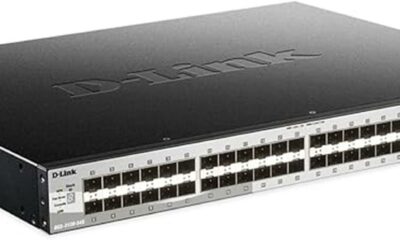
 Vetted5 months ago
Vetted5 months agoD-Link Switch Review: Lite Layer 3 Managed Networking
-

 Tableware and Dining Accessories7 months ago
Tableware and Dining Accessories7 months agoWhat Is the Meaning of the Word Tableware
-

 Tableware and Dining Accessories7 months ago
Tableware and Dining Accessories7 months agoWhat Is the Hindi Meaning of Tableware

















